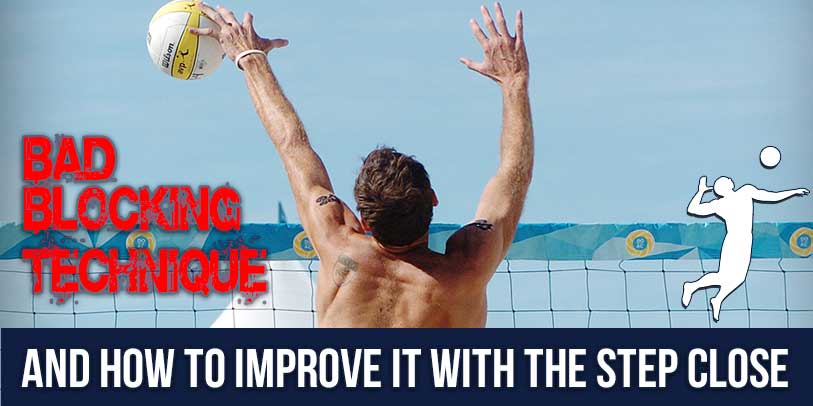In this video series I review what I think is some bad blocking technique by Ryan “Avatar” Doherty. I love Ryan as a person and all that he does for the sport of beach volleyball. I highly encourage you to pick up his book (Avatar’s Guide to Beach Volleyball: Everything you need to know about the sport from the only professional player that writes) or follow him on social media. His blocking technique, as of 3/23/17 would recommend you avoid.
How I believe he can become better using the Step Close Blocking Technique:
- Jump Even Higher
- Penetrate Even Further
- Be Better at Pulling,
- Better At Moving Into a Spot and Taking the Hard Ball
- Better at Reading the Hitters,
- Better at Closing Out the Hitter’s Approach Angle,
- Have a More Aggressive Mindset,
- Be Better at Moving Along the Net,
- Be Better at Double-moves and Fake Blocks,
- Be Better at Stopping plays,
- Allow for Different Deception when Shaping the Mind of his Opponent.
- May allow your partner on defense to “Read the Game” better.
To see instructional videos on the Step Close Blocking Technique please click the link.
Video 1
Video 2
Related Videos:
Ryan Doherty Beach Volleyball Blocking Mistakes verses Ricardo and Alison








IMHO always keeping one leg back when when the opposing setter is setting the ball is bad practice. It’s OK if the pass is really bad, but usually at a high level you should be pulling very rarely on good passes. Keeping your shoulders square to the net optimizes for the most common situation, helps you to be not over-rotate on the block, and allows you to be laterally mobile in case of an outside or back set, especially on a shoot to the pin.
Lateral movement in particular becomes very difficult if you have to, e.g., step right while your left foot is back. Also, keeping the foot off the net that you are going to open up with as you recommend with blatantly gives away the side you are blocking.
Watching some FIVB videos confirms that top-level players don’t do as you this. Can you explain your source and maybe post some videos of high-level players doing this on good passes? Thanks!
Hi Kevin, Thanks for your comment. To answer your questions:
1) Just because you want to end up close to parallel does that mean how you should start parallel? I think not especially if the benefits (Jumping Higher, better penetration, easier to pull, and more) exceed what you receive by being parallel to start.
2) This video is a great example of 2-3 easy points that could have be gotten with a better easy pull in my opinion. In a set top players have 2-3 blocks total. Having 2-3 good pulls that you convert to points is just as important. Blockers have two jobs, to block and to pull and dig!
3) Just because few male players at the top men’s level are doing it does that make it wrong? On the women’s side it is far more common. As I observe volleyball I think the trend is that women as a group are far more technically sound due to the increased number of hours they are playing the sport vs. men. You are seeing this technique more and more in women’s beach volleyball. I think this is due to the need to pull plus better fundamental coaching and the younger levels.
4) Lateral movement along the net in most cases is very controlled. Players normally starting outside or more inside. On plays the players feet are also switching based upon the play. I believe this technique actually allows for better lateral movement as players are not just moving forward but also sideways. It is easier to front a player moving forward and sideways vs. just moving sideways.
To add to this I find the mental need to move forward results in better movement in many cases as players are focused on fronting vs watching the ball.
5) In terms of giving away the side you are blocking that is incorrect. If the set is outside, your feet are the same on a line block or angle block. For a middle set your feet do show more of where you may block, however keep in mind your feet end parallel. This allows the blocker to block either way. Also you can explode better either way for 3 and 4 blocks with a step close.
Additionally if the attacker is now looking at your feet to decide where to hit, “Hicks Law” is kicking in which will slow down their reaction time and make them far less effective as a hitter. That benefit alone is massive and will give the blocker a significant advantage.
Finally, my source is teaching this and doing this. Innovation often comes from necessity and success. Most players, male, female, youth, older and pro prefer this after they have tried it a few weeks. I would suggest you do the same. Start with it on sets to the antenna and middle of the court. Film it and compare to what you normally do. Email me the link and I will be happy to review!
Also I will plan to add some more videos for your with examples! Again I appreciate and value your comments feedback, please keep it coming!!!
I would say that having your feet staggered like this is going to require a higher level athlete as well. the rotation and shoulder control on your inside hand have to be on point or you are leaving that inside hand off the net and letting them crush the angle.
Hi Steven,
I appreciate your comments! So I am not sure what you mean by leaving that inside hand off the net and crush angle. Both hands penetrate just as effectively if not more effectively than with parallel feet. See examples.
As for shoulder control and young players, in my experience, once a kid blocks you should and can teach them this. The benefits at the younger level are overwhelmingly in favor of this technique!
Thoughts?
Andor